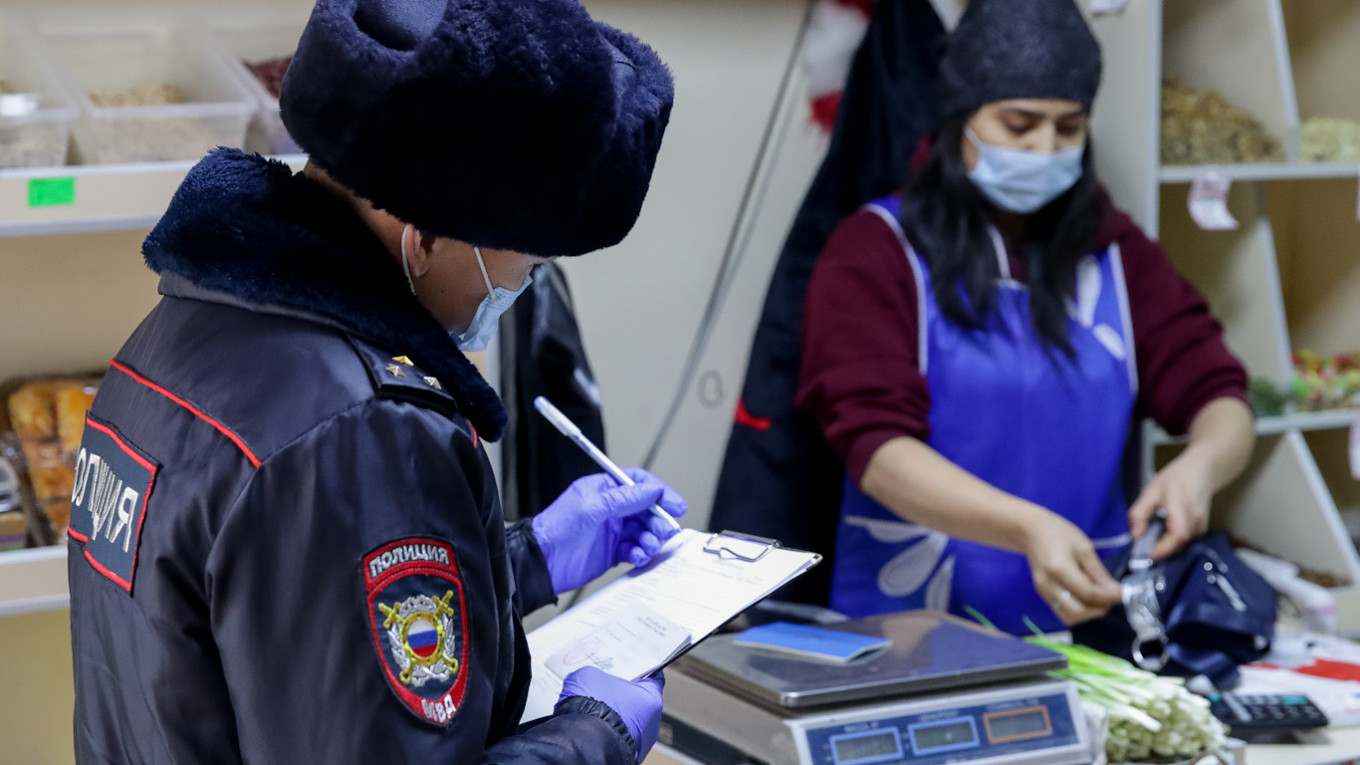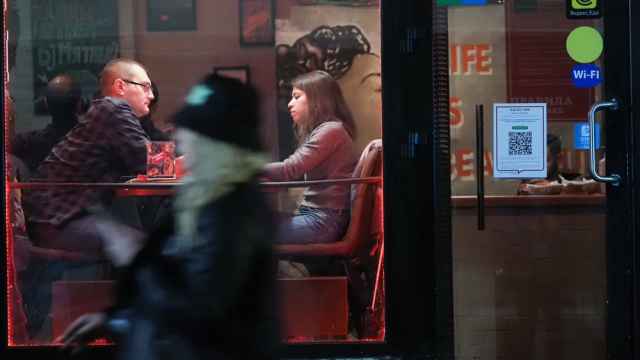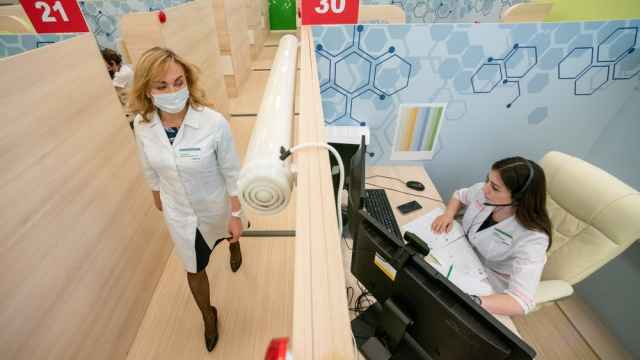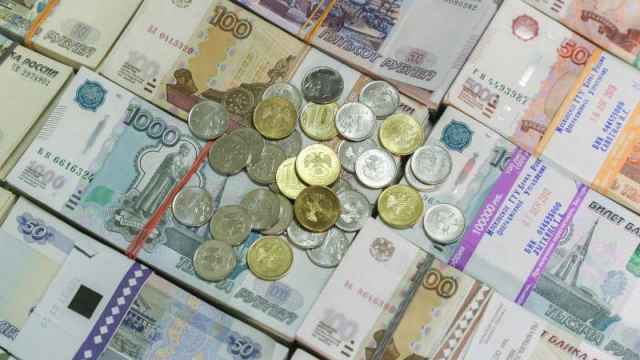Russia’s economic recovery was losing steam even before a second wave of the coronavirus took hold across the country, a fresh batch of official data has shown.
Rosstat, the official statistics agency, recorded a broad slowdown across the Russian economy in September, just as the numbers of new infections were starting to climb upwards — a trajectory which has since taken the pandemic to new heights. October has seen record-breaking numbers of deaths, thousands of hospitalizations, grim reports of overcrowded morgues and warnings that Russia’s regions could be hit ten times as hard as they were in the first wave.
The new data show Russia started the second wave — like countries the world over — with its economy significantly weakened and households facing increasing financial stress.
Russians’ real disposable incomes — a closely-watched indicator of living standards — recovered slightly in the third quarter of the year, Rosstat said, but nowhere near enough to reverse the steepest decline in two decades which was recorded in the spring. They have now fallen 4.3% this year.
A recent study of income tax receipts put that fall into cash terms, estimating that Russian workers lost more than $10 billion due to wage cuts and reductions in hours as a result of the pandemic — equivalent to 16 million workers’ all losing a full month’s earnings.
Meanwhile, Russia’s GDP was down 3.8% in the third quarter, the Economy Ministry said — another improvement from the 8% crash in the second quarter, but still not enough to raise hopes of a rapid V-shaped recovery.
In fact, the fall in GDP this year has wiped out three years of weak recovery after Russia’s most recent economic crisis, and taken the economy back to pre-2014 levels, as measured by GDP per capita and adjusted for inflation. Real disposable incomes have now fallen more than 11% over the same period — accelerating an already painful lost decade for Russians’ living standards.
Other economic indicators also disappointed. Both consumer spending and industrial production came in below expectations in September — down by 3% and 5% respectively on their levels over the same period last year. The fall in retail sales is of particular concern to economists, as it suggests that an increase in spending seen over the summer was more of a short-term boost following weeks of lockdown and the result of closed borders than the start of a sustained consumer-led recovery.
“The dynamics are deteriorating for the second month in a row, as deferred demand and anti-crisis social payments are winding down,” said Olga Belenkaya, head of macroeconomic analysis at Finam. An example is the package of extra monthly payments of around $130 for families with young children that ended in August.
“At the same time, the data for September do not reflect the sharp deterioration in the epidemiological situation in Russia, and the introduction of tighter restriction measures in many regions, including Moscow,” Belenkaya added.
The number of daily new reported cases has doubled since the end of September — from an average of 7,720 during the last week of the month to almost 16,000 over the last seven days. In response to the spike, Moscow authorities have ordered companies to ensure at least 30% of their employees are working from home, told over-65s to stay home and partially closed the city’s schools.
Hibernation
“Although businesses have not closed, the transfer of employees to remote work, an increase in the number of cases and fear of infection have led to a significant reduction in mobility and visits to restaurants and shopping centers. This threatens new challenges for a fragile business recovery,” Belenkaya said.
She pointed to spending data from Sberbank which shows “a gradual hibernation of the consumer” over recent weeks. Spending in the first week of October was the weakest since mid-June, when various quarantine restrictions were still in place across parts of the country. The bank also found an acceleration of spending in pharmacies — as was recorded during the first wave — while outlays on services like restaurants, cafes and hairdressers, was down by more than 20% on last year’s levels for the first time since the summer.
In Moscow, the drop has been particularly dramatic. In the first week of October, the number of customers in the capital’s bars and restaurants was running at levels almost comparable to 2019 — just 2% down. In the latest reading, which covers Oct. 12-18, that had crashed to minus 22%.
The Watcom shopping index, a broader measure of footfall in Moscow’s malls, is more than a quarter below 2019 levels — a sharp fall back after being almost level in the summer.
The one bright spot in the latest batch of data was official unemployment which showed a slight decline over September — a fact ministers and state media focused on in their analysis of the latest numbers.
However, economists are highly sceptical of Russia’s unemployment figures and even analysts from the Central Bank have said they believe “hidden unemployment” is on the rise. “The bad news is that the number of unemployed people has not reached a plateau level,” said Alfa Bank’s chief economist Natalia Orlova. “We expect this number to continue rising.”
Fewer options
The economic deterioration will be a disappointment for policymakers who had declared victory over the pandemic back in the summer and hailed Russia coming through the economic crisis in much better health than other developed countries.
Russia is still set to record a better performance than most developed economies even as the government has refrained from the kind of sweeping stimulus measures and generous support for businesses and households that others have rolled out.
The International Monetary Fund (IMF) is predicting a 4.1% contraction in Russia’s economy, while even the more pessimistic predictions, such as a 5% decline pencilled in by the World Bank, still show Russia as one of the least-affected big economies.
A general unwillingness to draw down the country’s multi-billion dollar reserve fund has also left policymakers with fewer options to counter the economic impacts of a second wave.
“The main difference between the first wave of the pandemic and the situation in the final quarter, is that the authorities now have much less capacity to support the economy,” said Orlova.
“With the Central Bank unable to cut interest rates right now, and growth in government spending expected to slow down by the end of this year, the government’s desire to avoid imposing strict quarantines is the only encouraging factor in the outlook for the fourth quarter,” she added.
That too, however, could be a source of further economic weakness. The government has insisted it is not considering reintroducing a broad lockdown — a measure which opinion polls show is opposed by most Russians and the business community.
Medical professionals in Russia say a new quarantine could be needed to get the virus back under control and avoid the healthcare system being overloaded. And evidence from the first wave suggests the trade-off between protecting the economy and controlling the virus could be a false premise — countries which saw fewer cases and deaths also saw their economies perform better and recover stronger.
“Economies that were slower to implement measures to stem the spread of the virus suffered more widespread outbreaks, higher death rates, and steeper declines in activity than economies that did so more rapidly,” a World Bank report found.
That’s because even without a strict lockdown, growing case numbers, fatalities and crackdowns on business not enforcing requirements to wear masks and gloves exert a chilling effect on the economy.
Experts expect that will be the case in Russia as temperatures in the capital hover above freezing and activities like al fresco dining, which helped restaurants recover over the summer, look less attractive.
“We expect consumers to return to austerity — even in the absence of stringent quarantine measures,” said Orlova.
In dry economic language, the World Bank summed up what that might mean for the wider Russian economy in the near future: “Risks to the economic outlook are heavily tilted to the downside.”
A Message from The Moscow Times:
Dear readers,
We are facing unprecedented challenges. Russia's Prosecutor General's Office has designated The Moscow Times as an "undesirable" organization, criminalizing our work and putting our staff at risk of prosecution. This follows our earlier unjust labeling as a "foreign agent."
These actions are direct attempts to silence independent journalism in Russia. The authorities claim our work "discredits the decisions of the Russian leadership." We see things differently: we strive to provide accurate, unbiased reporting on Russia.
We, the journalists of The Moscow Times, refuse to be silenced. But to continue our work, we need your help.
Your support, no matter how small, makes a world of difference. If you can, please support us monthly starting from just $2. It's quick to set up, and every contribution makes a significant impact.
By supporting The Moscow Times, you're defending open, independent journalism in the face of repression. Thank you for standing with us.
Remind me later.







